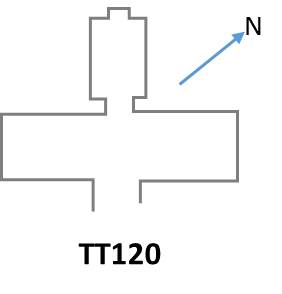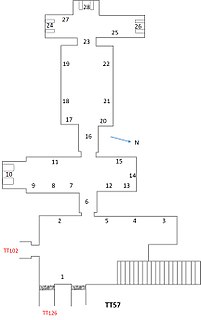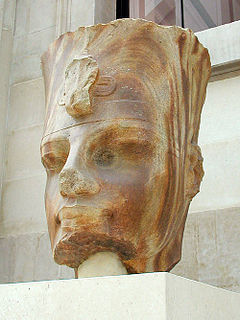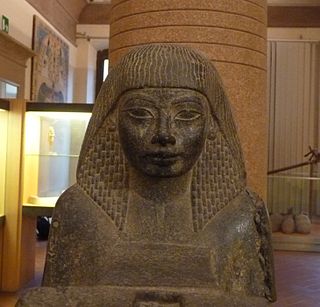
Neferneferuaten Nefertiti was an Egyptian queen and the Great Royal Wife of Akhenaten, an Egyptian Pharaoh. Nefertiti and her husband were known for a religious revolution, in which they worshipped one god only, Aten, or the sun disc. With her husband, she reigned at what was arguably the wealthiest period of Ancient Egyptian history. Some scholars believe that Nefertiti ruled briefly as Neferneferuaten after her husband's death and before the accession of Tutankhamun, although this identification is a matter of ongoing debate. If Nefertiti did rule as Pharaoh, her reign was marked by the fall of Amarna and relocation of the capital back to the traditional city of Thebes.

Tiye was the daughter of Yuya and Tjuyu. She became the Great Royal Wife of the Egyptian pharaoh Amenhotep III. She was the mother of Akhenaten and grandmother of Tutankhamun. In 2010, DNA analysis confirmed her as the mummy known as "The Elder Lady" found in the tomb of Amenhotep II (KV35) in 1898.

Amenhotep III, also known as Amenhotep the Magnificent, was the ninth pharaoh of the Eighteenth Dynasty. According to different authors, he ruled Egypt from June 1386 to 1349 BC, or from June 1388 BC to December 1351 BC/1350 BC, after his father Thutmose IV died. Amenhotep III was Thutmose's son by a minor wife, Mutemwiya.
The djed is one of the more ancient and commonly found symbols in ancient Egyptian religion. It is a pillar-like symbol in Egyptian hieroglyphs representing stability. It is associated with the creator god Ptah and Osiris, the Egyptian god of the afterlife, the underworld, and the dead. It is commonly understood to represent his spine.

Amenhotep I, Amenôthes I, or Amenophis I, (,) from Ancient Greek Ἀμένωφις, additionally King Zeserkere, was the second Pharaoh of the 18th dynasty of Egypt. His reign is generally dated from 1526 to 1506 BC. He was a son of Ahmose I and Ahmose-Nefertari, but had at least two elder brothers, Ahmose-ankh and Ahmose Sapair, and was not expected to inherit the throne. However, sometime in the eight years between Ahmose I's 17th regnal year and his death, his heir apparent died and Amenhotep became crown prince. He then acceded to the throne and ruled for about 21 years. Although his reign is poorly documented, it is possible to piece together a basic history from available evidence. He inherited the kingdom formed by his father's military conquests and maintained dominance over Nubia and the Nile Delta but probably did not attempt to maintain Egyptian power in the Levant. He continued the rebuilding of temples in Upper Egypt and revolutionized mortuary complex design by separating his tomb from his mortuary temple, setting a trend in royal funerary monuments which would persist throughout the New Kingdom. After his death, he was deified as a patron god of Deir el-Medina.

The Precinct of Mut is an Ancient Egyptian temple compound located in the present city of Luxor, on the east bank of the Nile in South Karnak. The compound is one of the four key ancient temples that creates the Karnak Temple Complex. It is approximately 325 meters south of the precinct of the god Amun. The precinct itself encompasses approximately 90,000 square meters of the entire area. The Mut Precinct contains at least six temples: the Mut Temple, the Contra Temple, and Temples A, B, C, and D. Surrounding the Mut Temple proper, on three sides, is a sacred lake called the Isheru. To the south of the sacred lake is a vast amount of land currently being excavated by Dr. Betsy Bryan and her team from the Johns Hopkins University in Baltimore, Maryland.

Sitamun was an ancient Egyptian princess and queen consort during the 18th Dynasty.

The ancient Egyptian noble known as Meryre II was superintendent of the queen Nefertiti, and had the title Royal scribe, Steward, Overseer of the Two Treasuries, Overseer of the Royal Harim of Nefertiti. He had a tomb constructed at Amarna, Tomb 2, although his remains have never been identified. The tomb has the last dated appearance of Akhenaten and the Amarna family, dating from second month, year 12 of his reign.

Siatum was an ancient Egyptian prince of the 18th dynasty. He was likely one of the sons of Pharaoh Thutmose IV and thus the brother or half-brother of Amenhotep III.

The Ancient Egyptian noble, Ramose was Vizier under both Amenhotep III and Akhenaten. He was in office in the last decade of Amenhotep's III reign and at the beginning of the reign of the latter king. Ramose appears on jar labels found in the palace of king Amenhotep III at Malkata. Here appears also the vizier Amenhotep-Huy. Both viziers are also shown side by side in the temple of Soleb. In the New Kingdom the office of the vizier was divided in a northern vizier and a southern one. It is not entirely clear whether Ramose was the southern or northern one.
The Tomb of Meryra is part of a group of tombs located near Amarna, Upper Egypt. Placed in the mountainsides, the graves are divided into north and south groupings; the northern tombs are located in the hillsides and the southern on the plains. Meryra's burial, identified as Amarna Tomb 4 is located in the northern cluster. The sepulchre is the largest and most elaborate of the noble tombs of Amarna. It, along with the majority of these tombs, was never completed. The rock cut tombs of Amarna were constructed specifically for the officials of King Akhenaten. Norman de Garis Davies originally published details of the Tomb in 1903 in the Rock Tombs of El Amarna, Part I – The Tomb of Meryra. The tomb dates back to the 18th Egyptian Dynasty.

The Theban Tomb TT120 is located in Sheikh Abd el-Qurna. It forms part of the Theban Necropolis, situated on the west bank of the Nile opposite Luxor. The tomb is the burial place of the Ancient Egyptian official, Anen who was the brother of Queen Tiye, and became Chancellor of Lower Egypt, Second Prophet of Amun, sem-priest of Heliopolis, and Divine Father under the reign of the Amenhotep III.

The Theban Tomb TT57 is located in Sheikh Abd el-Qurna. It forms part of the Theban Necropolis, situated on the west bank of the Nile opposite Luxor. The tomb is the burial place of the ancient Egyptian official, Khaemhat who was royal scribe and overseer of double granary, during the reign Amenhotep III. The relief decoration of the tomb is regarded as the best of New Kingdom art.

Amenhotep (Huy) was the high steward of Memphis under Amenhotep III in the Egyptian 18th Dynasty. With this title he was one of the highest officials at the royal court.
Meryre or Meryra was an ancient Egyptian male name, occurring both as a personal and as a throne name. A variant is Merenre, the female version is Merytre. Famous bearers were:

The colossal quartzite statue of Amenhotep III is an Ancient Egyptian sculpture dating from the 18th Dynasty. It was found in the massive mortuary temple of the pharaoh Amenhotep III on the West Bank of the River Nile at Thebes (Luxor) in Egypt. Only the head of the broken colossal statue survives. It is part of the British Museum's Department of Ancient Egypt and Sudan collection.
Articles related to ancient Egypt include:

Ptahmose was Overseer of the seals (Treasurer) under Amenhotep III, during the 18th Dynasty of Egypt.

The Sekhmet statues, dating back to the New Kingdom of Egypt during the 18th dynasty and later dynasties, are statues of the Egyptian goddess Sekhmet.

Amenhotep was an Ancient Egyptian official and chief physician of the early 19th Dynasty. He is mainly known from his decorated tomb chapel that was excavated in 1913/14 by Ahmed Bey Kamal at Asyut, in Middle Egypt.
















